| Columns Retired Columns & Blogs |
Jadis Orchestra Reference Mk.II integrated amplifier Measurements
Sidebar 3: Measurements
I measured the Jadis Orchestra Reference Mk.II using my Audio Precision SYS2722 system (see the January 2008 As We See It). I had a problem inserting the EL34 output-stage tubes: the positioning lug on the tube's bottom didn't make a sufficiently positive engagement with the matching cutout in the ceramic tube base. I broke one EL34 when I thought I had it correctly inserted but found out it wasn't—when I removed the tube to reinsert it correctly, its plastic base broke off. Before beginning the testing, I carefully reinserted the broken tube in the correct orientation—the Orchestra's heater circuit is active for the output tubes only when all four tubes are installed and making contact. However, the right channel didn't produce an output—later, I discovered that an internal fuse was blown—so I continued the testing on the left channel.
But when I began to examine the Orchestra's linearity, I ran into another problem. The THD+noise at 500mW into 8 ohms was very high, at almost 1% of pure second harmonic, which seems much too high for a design using EL34 tubes.
Concerned that our sample of the Orchestra Reference Mk.II had been damaged in shipping from Art's place to mine, I informed Bluebird Music, Jadis's North American distributor, of this; they sent me a new set of tubes, in case the high distortion was due to a faulty tube. With its tubes and fuse replaced, the Orchestra's THD+N at 500mW into 8 ohms dropped to a more reasonable 0.29%. However, when I plotted how the THD+N varied with power with the new tubes, the distortion rose rapidly, reaching 1% at 2.8W into 8 ohms and 3% at 19.8W into 8 ohms.
I contacted Bluebird again, who reminded me that, as the Jadis Orchestra is a fixed-bias design, I needed to reset the bias for the four output tubes. They sent me the relevant pages from the service manual to show me how.
I turned the amplifier upside down, carefully balanced it on its tube cage and transformers, and removed the bottom panel. The bias is set by measuring the DC voltage across each tube's plate resistor and adjusting a small trim pot until the voltage measures 200mV. With the new tubes, the voltages across the plate resistors before adjustment were 138 and 31mV (left), and 158 and 134mV (right). After adjustment, the best I could achieve were 198, 199, 205, and 202mV, respectively—all very close to the correct value, and better matched between each pair. A spot check of distortion indicated that the Orchestra's linearity was also much improved, so I replaced the bottom cover, turned the amplifier right-side up, and resumed testing.
The Orchestra Reference Mk.II preserved absolute polarity (ie, was non-inverting). Its sensitivity is specified as 250mV for full output, equivalent to 37.1dB. My measurement of the maximum gain at 1kHz into 8 ohms was somewhat lower, at 33.3dB. While the amplifier's input impedance is specified at >100k ohms, my measurement was lower, at 29k ohms at 20Hz and 1kHz, dropping slightly to 27k ohms at 20kHz. These impedances are still usefully higher than the norm, however, and won't load down source components.
The output impedance was very high, at 3 ohms across the audioband, which means that with our standard simulated loudspeaker, the variations in response due to the interaction between the output impedance and that of the speaker reach an audible ±1.8dB (fig.1, gray trace). The audioband response into purely resistive loads is extremely flat, however, though it gently rolls off in the low bass. Note the sharp rolloff above 40kHz, reaching –3dB at 50kHz into 8 ohms (fig.1, blue and red traces). Note also the presence of a small resonant peak at 100kHz, which results in a single damped cycle of ringing with a 10kHz squarewave (fig.2). Commendably, the responses in fig.1, taken with the volume control set to its maximum, didn't change at lower settings.

Fig.1 Jadis Orchestra Reference, volume control set to maximum, frequency response at 2.83V into: simulated loudspeaker load (gray), 8 ohms (blue), 4 ohms (magenta), 2 ohms (red) (2dB/vertical div.).

Fig.2 Jadis Orchestra Reference, small-signal, 10kHz squarewave into 8 ohms.
Channel separation at 1kHz was good in the L–R direction, at 76dB, but less so R–L: 60dB. The wideband, unweighted signal/noise ratio, ref. 2.83V into 8 ohms and taken with the input shorted but the volume control set to its maximum, was an okay 70.75dB (average of both channels), increasing to 86.1dB when A-weighted. Spectral analysis of the amplifier's noise floor indicated that the primary sources of noise are spuriae at the AC mains frequency of 60Hz and its harmonics (fig.3).
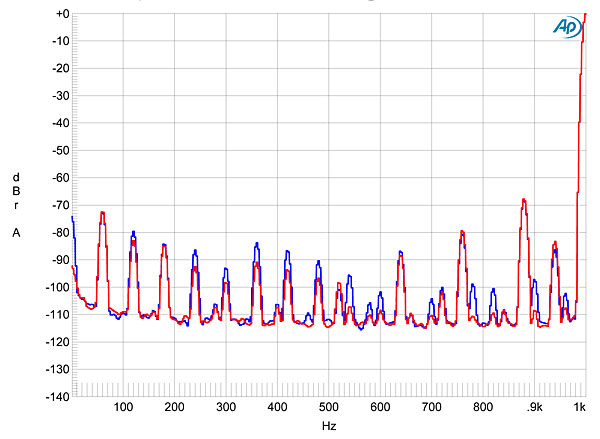
Fig.3 Jadis Orchestra Reference, spectrum of 1kHz sinewave, DC–1kHz, at 1W into 8 ohms (linear frequency scale).
Fig.4 plots how the percentage of THD+N changes with output power into 8 ohms. The THD begins to rise above the noise around 2W, and though not very low, it's typical for a design using a single pair of EL34s. The distortion gently rises above that power, suggesting that the Orchestra uses only a modest amount of negative feedback, and reaches 1% (our normal definition of clipping) at 26Wpc (14.15dBW). The Orchestra reached its specified maximum power of 40Wpc (16dBW) at 1.35% THD+N, and at 3% THD+N it delivered 59W (17.7dBW). Although Jadis says the Orchestra is optimized for a 4 ohm load, repeating this test into 4 ohms (fig.5) indicated a slightly higher level of distortion at low powers into this load, and the amplifier reached 1% THD+N at 15.5Wpc into 4 ohms (8.9dBW), and 40Wpc at 2.6% THD+N.
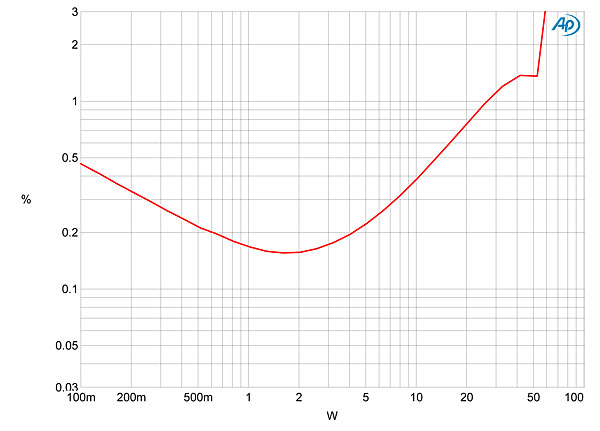
Fig.4 Jadis Orchestra Reference, distortion (%) vs 1kHz continuous output power into 8 ohms.
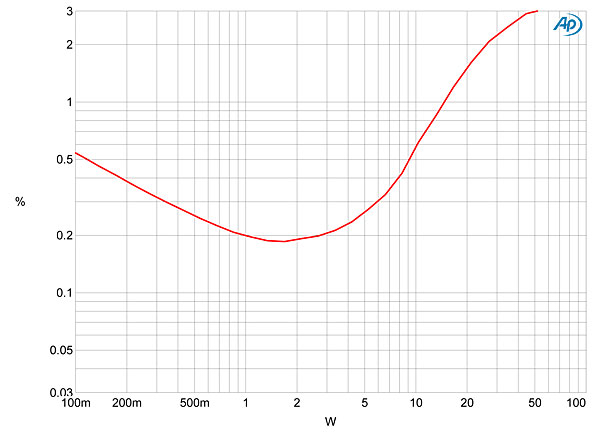
Fig.5 Jadis Orchestra Reference, distortion (%) vs 1kHz continuous output power into 4 ohms.
This dislike of low impedances can also be seen in fig.6, which plots the THD+N percentage against frequency at a modest output level into 8, 4, and 2 ohms. You can see that the right channel (red and magenta traces) is better behaved than the left (blue, cyan)—was this due to the slightly higher bias voltages?—and that the Jadis really doesn't like 2 ohms (gray).
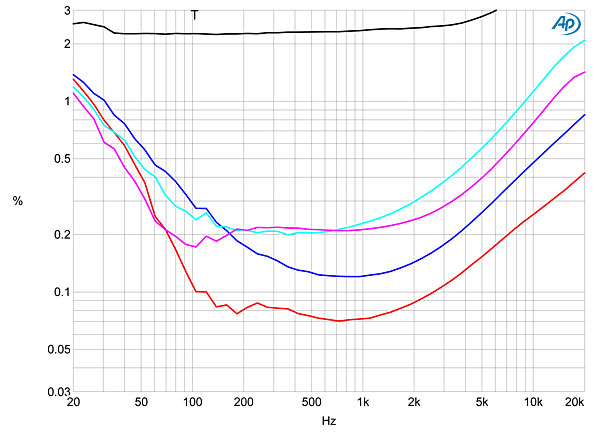
Fig.6 Jadis Orchestra Reference, THD+N (%) vs frequency at 4V into: 8 ohms (left channel blue, right red), 4 ohms (left cyan, right magenta), 2 ohms (gray).
The distortion waveform appears to be a mix of the second and third harmonics (fig.7), this confirmed by spectral analysis (fig.8). Fortunately, intermodulation distortion was relatively low, especially at modest powers into 8 ohms (fig.9).
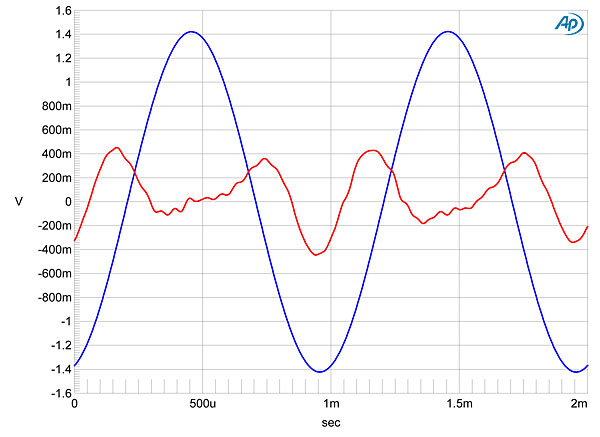
Fig.7 Jadis Orchestra Reference, 1kHz waveform at 2W into 8 ohms, 0.115% THD+N (blue); distortion and noise waveform with fundamental notched out (red, not to scale).
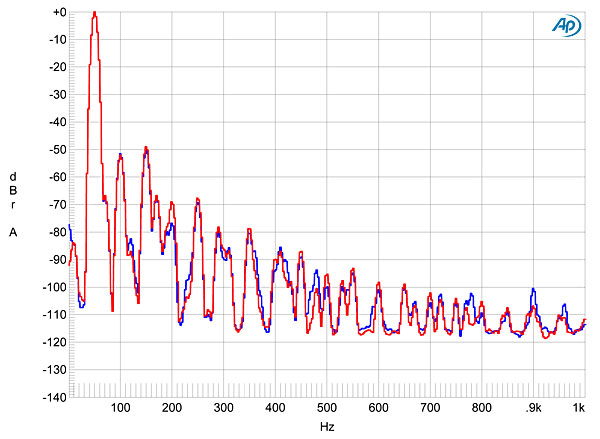
Fig.8 Jadis Orchestra Reference, spectrum of 50Hz sinewave, DC–1kHz, at 2W into 8 ohms (linear frequency scale).

Fig.9 Jadis Orchestra Reference, HF intermodulation spectrum, DC–24kHz, 19+20kHz at 2W peak into 8 ohms (linear frequency scale).
Once I had the new tubes installed and their biases optimized, the Jadis Orchestra performed relatively well on the test bench, given its circuit topology. But I do question the wisdom of choosing fixed bias for the output tubes, given how fussy the amplifier seems to be about the bias setting and the fact that, if the owner needs to replace a tube, it means a trip to the dealer to have a service technician readjust the bias.—John Atkinson
- Log in or register to post comments




































